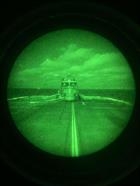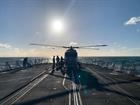HMS Northumberland helps push student pilots to the limit
HMS Northumberland have helped push navy aviators of the future to the limit to prepare them for operations around the world.
Every pilot who wishes to operate with the Royal Navy must know how to land their aircraft on the deck of a warship in all conditions, day and night.
It’s no simple task with the ship pitching and rolling beneath, but it’s a rite of passage naval fliers must go through to ensure they are ready for the rigours of front-line missions.
Plymouth-based Type 23 frigate Northumberland has been on operations in waters close to the UK and, during that time, worked with student pilots of 825 Naval Air Squadron and their Wildcat helicopters.
In the crashing waves in the English Channel, Lieutenant Lucas Harrisson is one of those who has been learning to land his helicopter on Northumberland’s deck.
“It’s like landing a helicopter on one half of a tennis court, if that tennis court was moving at 30 mph and didn’t like you. Oh, and it’s dark,” he said about the training.
Six student pilots were put through their paces to learn how to take off and land in a range of weather conditions by the frigate and squadron’s instructors.
The instructors up the ante after the students have mastered landing on a moving ship during the day, as they are then tasked with manoeuvring their aircraft in pitch darkness using Night Vision Goggles.
By time the two weeks of training is completed, the students are flying on their own as part of a two-student crew.
“It’s a big step in any naval aviator’s career,” said Lieutenant Commander John Phillips, in command of the squadron’s detachment on board Northumberland .
“They need to learn quickly, in a high-pressure environment. Once trained here, the next time they do this will be on the front line, and it could be to the deck of a warship anywhere in the world.”
The squadron from RNAS Yeovilton in Somerset also deployed with student engineers, many of whom were experiencing life at sea for the first time.
The engineers learnt about routines on a warship, how to maintain the helicopter while deployed and manage the flight deck around the clock.
It’s about developing their technical knowledge but also enables them to appreciate the stresses and strains of maintaining aircraft on fast-paced operations in often tricky conditions.
“For the young engineers this is the proper life of a Naval Air Engineer; noise, crashing waves, pressure of moving a multi-million pound aircraft into and out of the hangar as a team; it’s why they joined up,” said Chief Petty Officer Adam Gilder-Stevens.
Commanding Officer of HMS Northumberland, Commander Thom Hobbs RN, added: “The last few weeks have been a fantastic training opportunity, not only for the junior aircrew, but also for the ship’s company who have gained a huge amount of experience in flight operations to best prepare for the ship’s upcoming deployment in the New Year.”
The trainees will qualify in early 2022 and may even find themselves back on Northumberland during operations.






